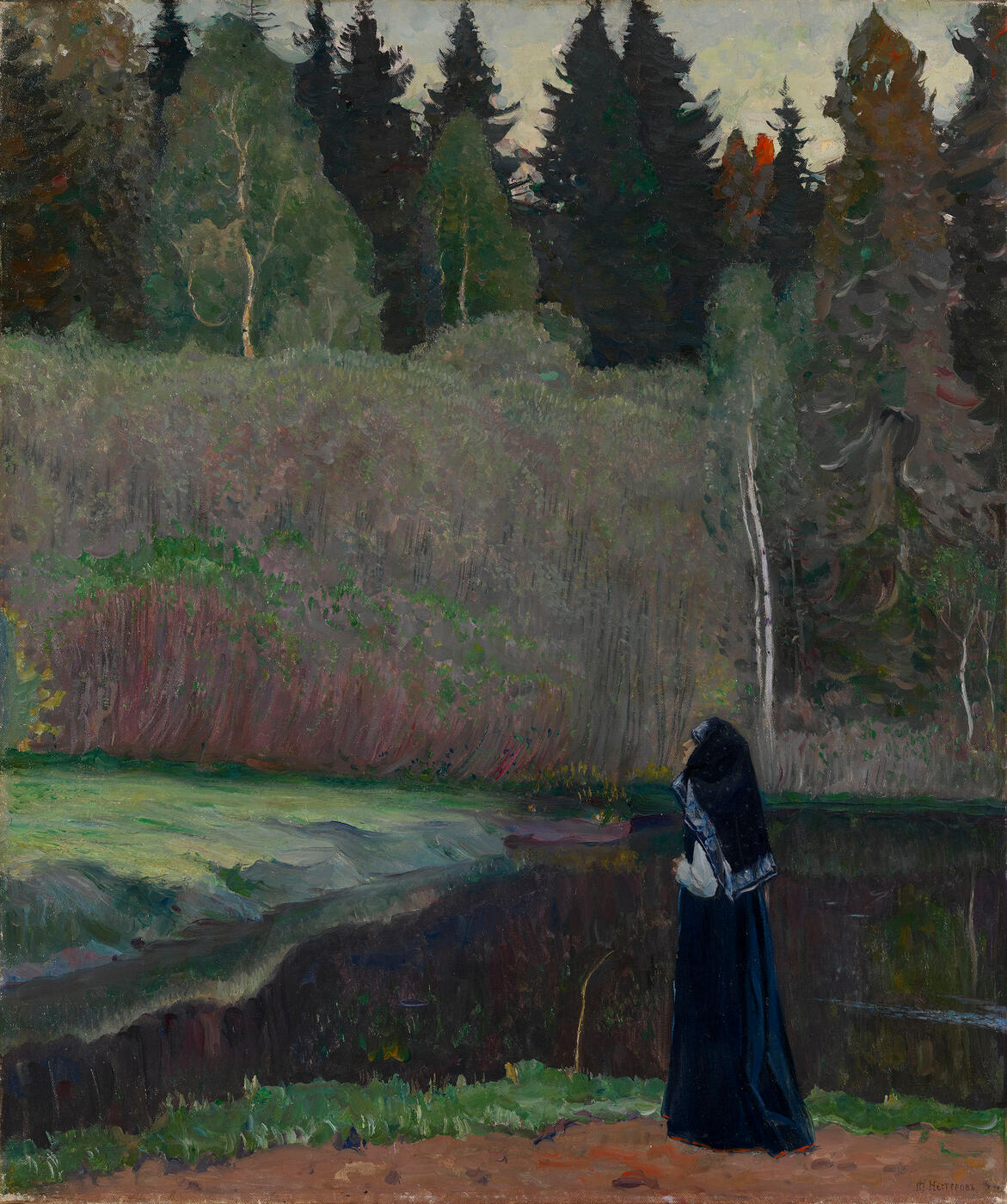MacDougall's Russian Art Auctions 1 December 2011
1 December 2011

10. NESTEROV, MIKHAIL (1862-1942)
The Nightingale is Singing, signed and dated 1918.
Oil on canvas, 81 by 68.5 cm.
600,000-900,000 GBP
Provenance: Private collection, UK.
Authenticity certificate from the expert V. Petrov.
Related literature: For a later version of the same composition, see Russkaya dorevolyutsionnaya i sovetskaya zhivopis’ v sobranii Natsional’nogo khudozhestvennogo muzeya Respubliki Belarus’, Vol. 2, Minsk, Belarus, 1997, p. 178, No. 1189, illustrated.
Mikhail Nesterov’s The Nightingale is Singing is one of his earliest versions of the celebrated 1917 composition, of which the artist painted at least four. It is now impossible to establish what became of the 1917 original, which, according to contemporary sources, was a larger-scale work than the later versions. We know for certain that a picture of the same name was sold at the famous Russian Art Exhibition in America in 1924 (and it is possible that this and the present work are one and the same). Another version, painted in 1922, is in a private collection in Kiev and the 1929 work that concludes the series is in the collection of the National Art Museum of Belarus.
The well-known avant-garde theatre director and theorist Nikolai Evreinov visited Nesterov’s studio in the early 1920s and wrote that: “Among the versions of subjects that I knew well I found my eyes glued, so to speak, to the spellbinding work The Nightingale is Singing which Nesterov had painted in 1917. The subject is not complicated: in early summer, a young novice nun stands by a dreamy lake bordered by a beautiful forest and listens breathlessly to the song of Nature pouring forth in the nightingale’s trilling; and on her lips, which have vowed never to know a sinful kiss, is a smile — such a sad smile, so understandable, so human!”
The story of how this subject arose is closely linked to Nesterov’s cycle of works dedicated to nuns, the “brides of Christ”, which he created over twenty long and extremely fruitful years. He conceived The Bride of Christ as a memorial to his beloved wife who had died unexpectedly. He first painted a large study of a girl lost in thought, in a dark dress with a little stalk of grass in her teeth and “with the face of my Masha”. In the words of one who had seen this now-lost work, “you could stand before this pensive girl for a good while and ponder for hours that mystery of life that she too is pondering. And in those thoughtful eyes there was so much that was familiar and close to us, such a revelation of the deepest recesses of the female soul that, looking into them, you could not help but recall the similar pensive heroines of Melnikov-Pechersky, his Flenushka and others, and the whole of our native Rus and its God-seeking people.”
“With this picture” said Nesterov later, “I had reached a turning point and something had appeared that would later grow more consistent, something well-defined, which gave me my ‘persona’... My love for Masha and my losing her made me into an artist, brought to my art what had been missing: emotion and a living soul — in a word, everything that people would later come to value and still value in my art.”
And indeed, The Bride of Christ immediately attracted serious critical attention. With this work, the artist’s destiny was decided. Continuing his initial theme, between the 1890s and 1910s Nesterov painted a whole story in pictures dedicated to the fate of the innocent girl, partly serving to develop the theme of his own sweet melancholy and partly inspired by Pavel Melnikov-Pechersky’s twin works In the Woods and In the Highlands.
However, according to the celebrated writer and close friend of the artist S.N. Durylin, it was The Nightingale is Singing that “became one of the most poetic versions of Nesterov’s theme of the fate of the Russian woman. Again we have a bride of Christ, but this time the artist brings her outside the convent walls one peaceful May evening to the edge of the forest, basking in the fragrant warmth of spring, while the nightingale’s song of love and paean to springtime makes her forget for a moment all her vows to obey, to pray and to ‘withdraw from the world’… We cannot see the nightingale in the picture, but we hear its song in the fragrant stillness of that spring evening, a stillness that seems to hear and respond, and the subject of the song is clear: youth, happiness and love.”
Indeed, in the delicately observed motif of the nightingale’s song, which seems to come from beyond the bounds of the picture, a theme resonates which was of great significance in Nesterov’s work — the theme of music bringing man and nature into harmony. As we look at this picture, we are reminded of what Vasily Rozanov said of Nesterov in 1907, in connection with the gloomy and oppressive state of Itinerant painting, and his words seem prophetic: “Then, like the resonant song of the skylark from a warm, blue sky, we heard the music and the musicality of Vasnetsov and Nesterov. ‘To the sky! To the sky!’ And we all looked to the sky. That is why we love them!”
Notes on symbols:
* Indicates 5% Import Duty Charge applies.
Ω Indicates 20% Import Duty Charge applies.
§ Indicates Artist's Resale Right applies.
† Indicates Standard VAT scheme applies, and the rate of 20% VAT will be charged on both hammer price and premium.